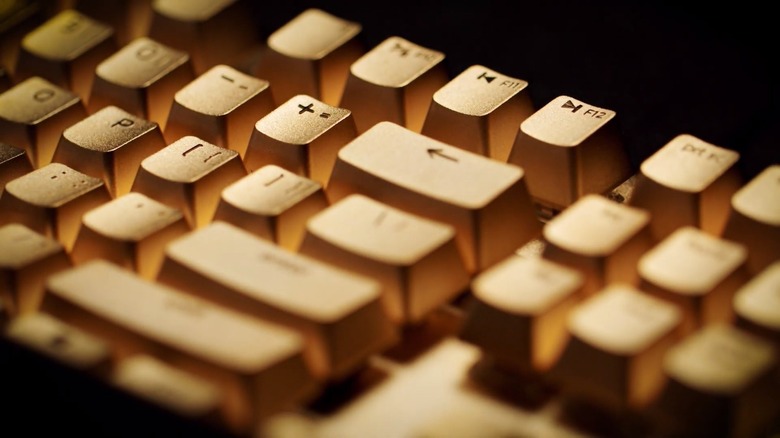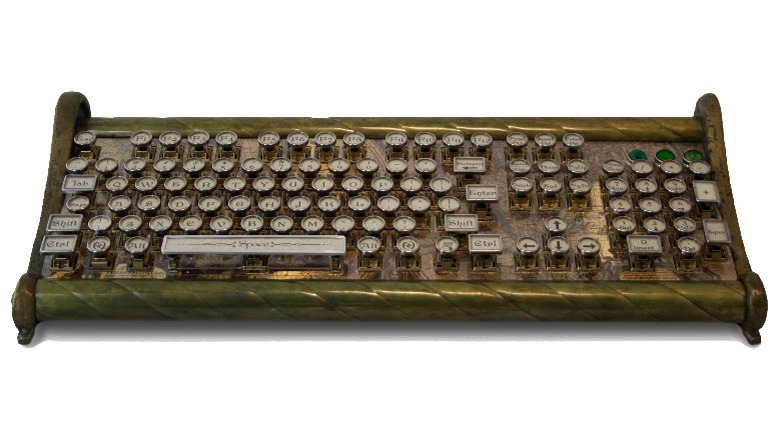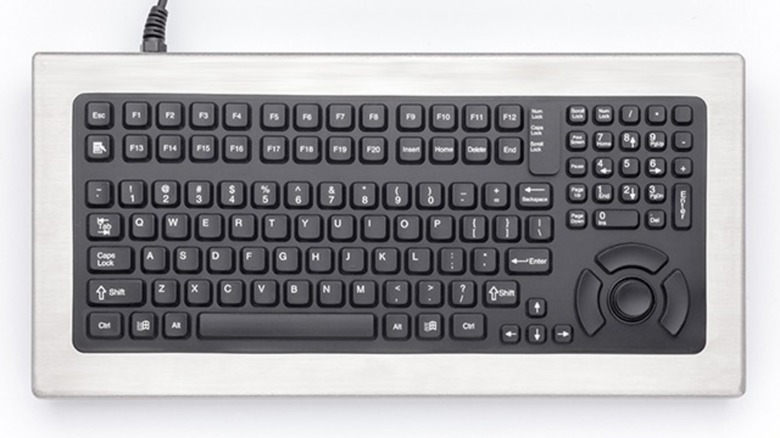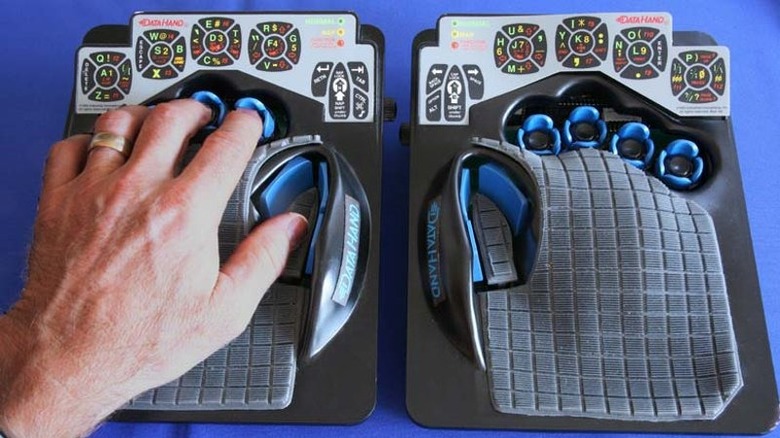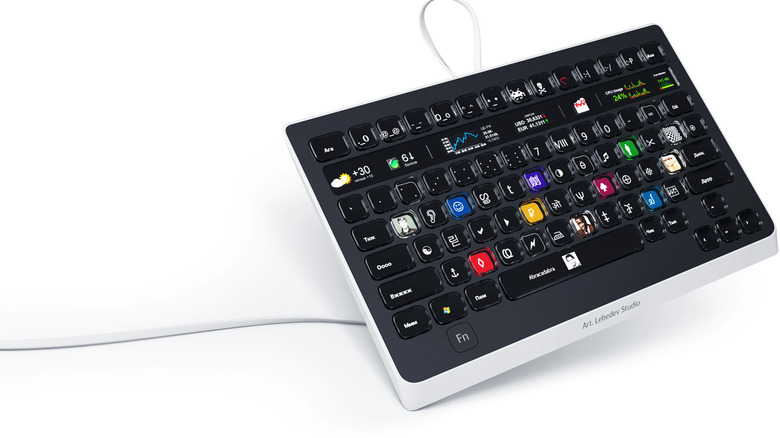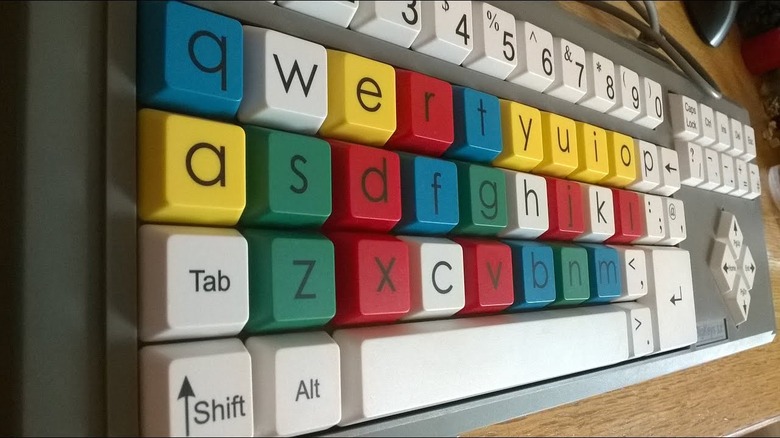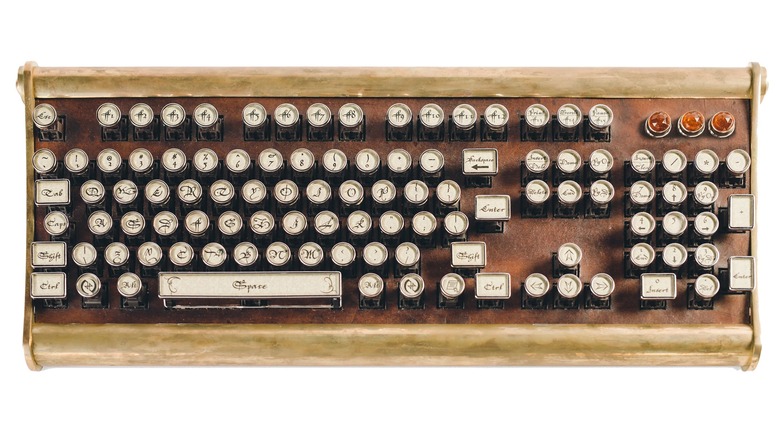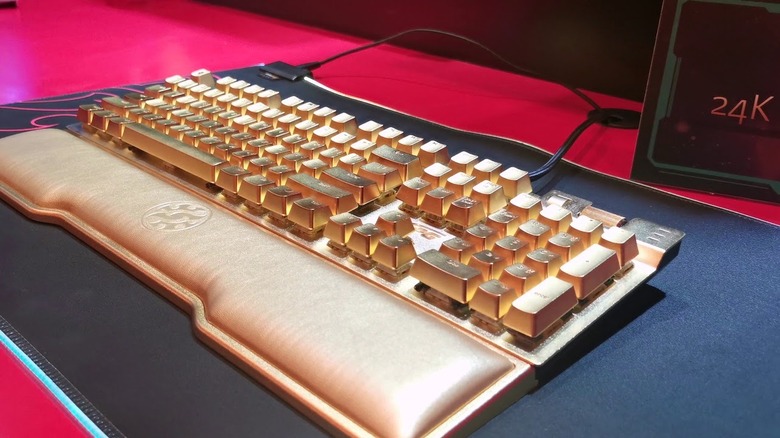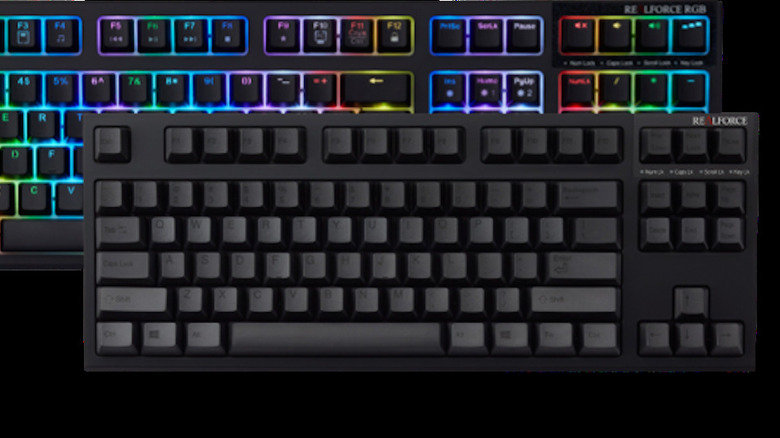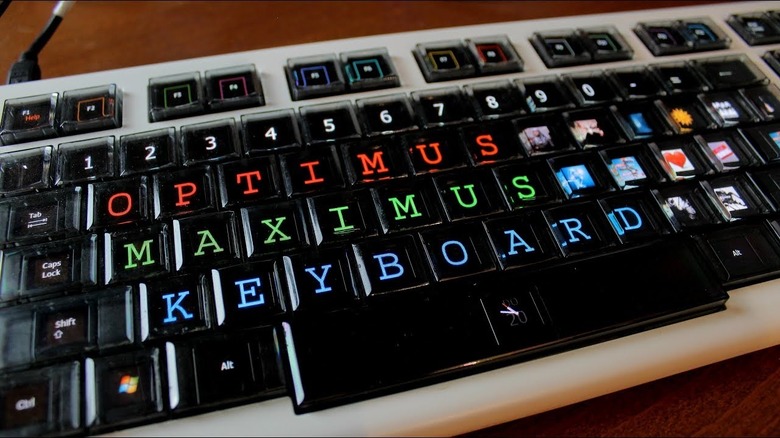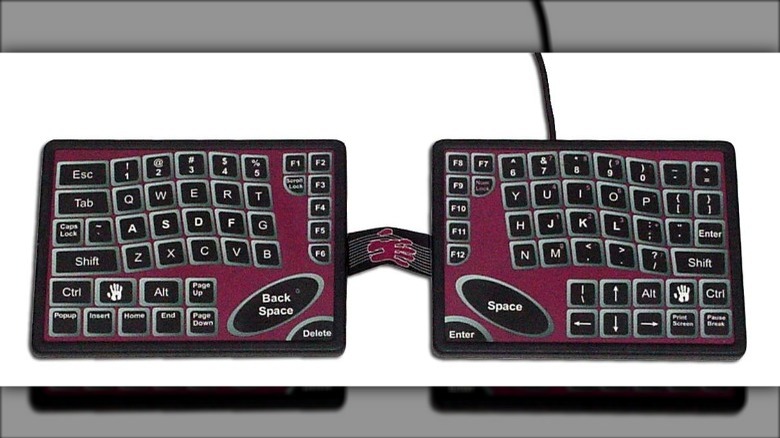The Most Expensive Keyboards That May Be A Total Waste Of Money
We may receive a commission on purchases made from links.
For anyone who spends much of their week at their computer, a good keyboard is vital. Membrane keyboards are the cheapest and most readily available form, but users who want a more customizable experience often opt for a mechanical keyboard. They're then able to choose everything from their favorite sounding switch to the RGB lighting that illuminates their keys. Personalizing a keyboard this way is considerably more expensive, but it's well worth it to get something that's suited exactly to your personal tastes.
However, not every expensive keyboard is worth the money. The costliest boards come with eye-watering price tags, some retailing for as much as a well-specced gaming PC. These boast luxurious materials, unique designs, or extra functionality, but many are so overpriced that it's hard to see them as anything other than a waste of money. Still, anyone who fancies dropping hundreds or even thousands of dollars on one will have plenty of options, from a gold-plated board to one that's supposed to look like it's been sat "in the backpack of an intrepid explorer."
Datamancer Seafarer - $1,299
There are niche keyboard designs, and then there's the Datamancer Seafarer. This $1,300 board is designed to look like a weather-beaten typewriter with a nautical theme, complete with pre-worn brass components. It features a gold foil print with a map drawn by a renowned cartographer, and a spiral pattern across the top and bottom edges of the keyboard that looks like a scroll. It also includes indicator lights designed to look like green jewels.
In terms of componentry, it's a fairly standard mechanical keyboard, with Cherry MX switches and functionality for various different layouts. It certainly looks very old-school, with the keys using an ornate typeface that wouldn't look out of place on the sign for a pirate ship ride at a theme park. A fun novelty for sure, but at such a high price point, it's hard to imagine many people would be willing to shell out the cash for one. Not to mention, its raised brass edges would presumably make it quite uncomfortable to use for longer periods of time.
iKey DT-5K-FSR-IS - $2,500
For a keyboard that costs more than most people's PCs, the iKey DT-5K-FSR-IS looks unremarkable. That's because its strengths lie in its utility rather than any aspect of its design. Its manufacturer says that it's designed for use in hazardous locations, with a non-corrosive stainless steel case that protects it from the worst that any factory, power station, or another industrial setting can throw at it. It's able to operate at temperatures of -4°F to 140°F (-20°C to 60°C), and it can withstand humidity of up to 100%.
It's an impressive piece of kit, but there's no getting away from the fact that this is a simple keyboard with a retail price of $2,500. It's also only compatible with Windows PCs, so Mac or Linux users are out of luck. In a few select industrial settings, the iKey is probably worth the money, as it's one of the safest and most reliable options on the market. But, for the vast majority of users even in less extreme industrial settings, the ultra-resistant utility of this keyboard won't justify its sky-high price tag.
DataHand Pro II - $1,200
It doesn't look like a keyboard at all, but the DataHand featured an innovative layout that allowed users to type with just the tips of their fingers. It was designed to prevent repetitive strain injury from hours of typing, and although it was tricky to get used to, user reviews suggest that it was effective at preventing strains and injuries. In a long-term review of the board, one reviewer revealed that they'd paid $1,200 for the DataHand, and they'd had to take several weeks off from their job to relearn how to type, as the device was so unlike anything that they had used before.
Steep learning curves aside, the DataHand did seem to be more comfortable to use for intense typing, although its high price no doubt put potential buyers off. The device was only produced for a few years in the late '90s, with updated versions available sporadically for the first half of the following decade. It's now a cult collectors' item, with prices for working units sitting at around the original retail price.
Optimus Popularis - $1,100
One of several unique keyboards produced by the Art Lebedev studio, the Optimus Popularis features 77 keys, each with an individual LCD screen that can be configured to display any character. Each of these screen keys has a resolution of 72 x 72 pixels, and each refreshes at a minimum of 10 frames per second (fps). In a hands-on review, KeyboardCo praised the Popularis' build quality, reporting that its mix of aluminum and plastic construction gave it a premium feel that was on par with a top-spec mechanical keyboard.
However, at a price of $1,100, the Popularis is more of an expensive novelty than a practical everyday keyboard. Setting it to a common layout like UK or US English arguably negates the point of buying the Popularis altogether, yet that's exactly what most people will need it for. Although programming it to display pictures, a clock or any other widget will be fun at first, it's certainly not $1,000 worth of fun for most people.
BigKeys LX - $200
While it's nowhere near as pricey as some of the other options here, the BigKeys LX is still on the upper end of what most PC users would be willing to shell out for a keyboard. It retails for around $200, yet it doesn't boast an attractive design, high-end materials, or extra functionality. Instead, its oversized keys and simplistic, colorful layout were designed to help people who would have trouble operating a regular keyboard.
The issue is that it's simply not very good. In fact, TechRadar even included it on their list of the worst keyboards of all time, because its poor build quality, sticking keys, and unintuitive design meant that, despite its maker's claims, it was significantly trickier to operate than a regular board. The TechRadar article also points out the LX's questionable looks, with its childlike design seeming a bit condescending to anyone who genuinely has trouble operating a keyboard because of a disability. There are plenty of other accessible options out there that both look better and work better, and many of them cost a lot less than $200.
Datamancer Sojourner - $899
Datamancer says that the purpose of the Sojourner keyboard is to be "reminiscent of an earlier era, when beauty and technology went hand-in-hand." Much like the nautical-themed Seafarer, the Sojourner features a worn brass frame that's artificially tarnished for a weather-beaten look. The face plate is made of aged brown leather, and each key is wrapped in metal casing to simulate the feel of an old typewriter. At $899, it's less expensive than the Seafarer, but still multiple times more than most enthusiasts would feel comfortable spending on a keyboard.
The usual gold-standard Cherry MX switches feature on the Sojourner, and it's built to be compatible with all major operating systems, including Linux. The strangest thing about the keyboard is its typeface, which Datamancer calls "Elizabethan." It's unusually squiggly, making it almost impossible to read at a glance, and for some keys, even difficult to read close up. A small inconvenience, but one that's going to get annoying, especially for an unfamiliar user trying to get to grips with the keyboard's function keys.
Adata Golden Summoner - $10,000
Possibly the most blinged-out keyboard on the market is the Adata Golden Summoner, which was first shown off at CES 2020. It costs a reported $10,000, and it's completely covered in 24-carat gold plating. The keys underneath are aluminum, making this one of the heaviest keyboards on the market as well as the priciest. According to TechRadar, the board was commissioned by one of Adata's particularly wealthy customers, and a total of six units were made.
Apart from being smothered in one of Earth's most precious metals, there's very little that appears to be mechanically different about the Golden Summoner. Underneath, it looks like a stock XPG Summoner, which retails for around $150. Even the standard volume roller in the top-right corner appears to be present, albeit in a much shinier form than the standard version. It should be pretty obvious that spending an extra $9,850 to bling out a $150 keyboard is not a good value proposition, but clearly, six people had more money than sense. And so, behold possibly the most pointlessly pricey keyboard ever made.
Happy Hacking Keyboard Professional HP Japan - $4,240
The gold-plated Adata keyboard might take the crown for the silliest way to spend $10k, but it doesn't actually hold the official record for the most expensive production computer keyboard. That honor instead goes to the Happy Hacking Keyboard Professional HP Japan, which at $4,240, is still the record holder according to Guinness World Records. Like the Summoner, it's also dusted with gold, but the main reason for its four-figure cost is its use of Urushi lacquer from Japan.
Originally developed as a form of varnish, the raw sap of the Urushi tree is poisonous to the touch, and even breathing in its fumes can cause harm. The technique for refining the sap has been developed over thousands of years, and the finished product remains one of Japan's most desirable (and expensive) exports. The Happy Hacking keyboard comes with a layer of Urushi lacquer on every key, although none of those keys have letters printed on them. The board was released in limited numbers in 2006 to commemorate the brand's 10th anniversary.
Optimus Maximus Keyboard - $1,600
Like the Popularis but even bigger, the Optimus Maximus from Art Lebedev Studio features individual screens on all of its keys. Rather than an LCD screen like the Popularis, the Maximus features OLED screens across all 113 keys, which can be individually configured to display anything from images to video commands. The board is compatible with both Windows and Mac systems, and it uses an SD card to store personalized settings, which can be quickly switched between.
Much like the Popularis, the main issue with the Maximus is simply how useful it is once the novelty of being able to customize individual keys wears off. At a retail price of $1,600 (or £1,140 in the U.K.), it's close to ten times the price of a decent professional keyboard, yet in the real world, it's not that much more useful. Cnet also tested the board and reported that it was tricky to touch type with, as the tightly packed keys and mushy responsiveness led to lots of mistakes. Its configuration might perhaps be useful for a web developer, video editor, or gamer, but there are many keyboards out there that offer gimmick-free configurability for a fraction of the price.
Fingerworks TouchStream LP ZeroForce - $1,500
The Fingerworks TouchStream is undoubtedly one of the most unique-looking keyboards ever made, with a split design that could replace a standard keyboard and a mouse altogether. Both the keyboard and the mouse could be controlled using the same overlapping MultiTouch surface, and users could instantly switch between one and the other without having to move their hands. In theory, this meant less chance of strain on the hands and fingers, but in reality, the board had a high rate of return for intensive typists, who simply didn't find it comfortable enough (according to ErgoCanada).
The TouchStream went out of production only a few years after it launched, and by 2005, it was reported that Apple acquired Fingerworks and its patents, preventing any chance of a reissue. TouchStream keyboards are now very rare to find, with unopened examples listed for as much as $1,500 each. However, used examples of these keyboards also occasionally come up for sale on eBay, where they sell for a small fraction of that price. It certainly isn't worth the money to buy an unopened TouchStream, especially since it's not even comfortable to type with. But, for collectors, it's worth keeping an eye out for one of these retro oddities popping up on auction sites, as there simply isn't anything else like it.
